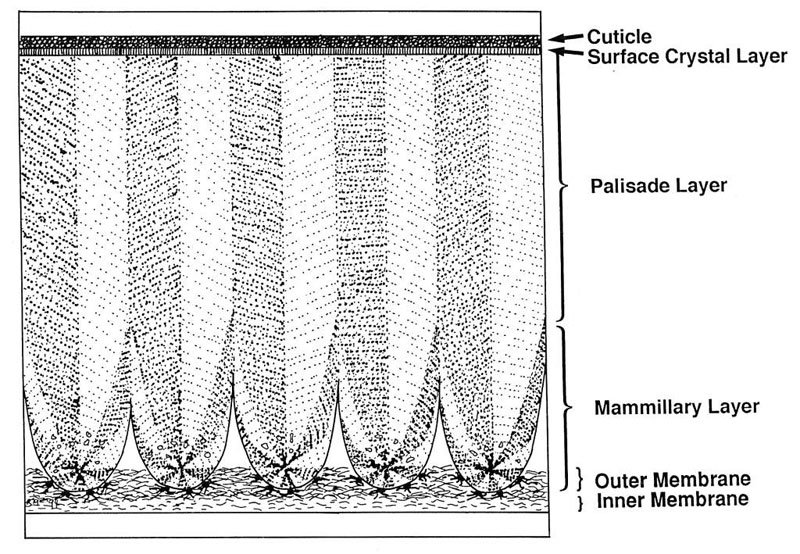A Poultry CRC research project is being undertaken at the University of New England, Australia (UNE) to examine how defects in shell quality and structure increase the risk that bacteria on the outside of the eggshell can enter the egg.
Sub-Project Leader, UNE’s Associate Professor Juliet Roberts, said that, essentially, the Australian egg industry produces a very safe product.
“Australia is fortunate in not having a problem with Salmonella Enteriditis in its layer flocks, as is the case in North America and Europe,” explained Associate Professor Roberts. “However, Salmonella Typhimurium causes problems with food-borne illness from time to time and some of these occurrences have been traced to the consumption of eggs. For this reason, the industry needs to be vigilant in monitoring the impact of food borne pathogens such as Salmonella in eggs and egg products.”
The project will investigate the incidence and significance of minor defects in the ultrastructure of the eggshell, such as translucency, which is where lighter colour spots are observed when an egg is candled over a light source. These spots appear when moisture from the egg albumen seeps into spaces within the fine structure of the eggshell, but they are difficult to detect in very fresh eggs.
“There is some evidence that translucent regions of the eggshell are more easily penetrated by bacteria than areas which are not translucent,” said Associate Professor Roberts.
Another feature of eggshells that will be investigated is micro cracks, which are very small fine cracks not visible to the naked eye and which can be difficult to detect by candling, particularly in very fresh eggs. Micro cracks have the potential to facilitate the entry of bacteria into the egg.
The project aims to address this industry issue by achieving the following:

Elucidating the correlation between egg shell translucency, shell strength and product safety in laying hens;
- determining the relationship between eggshell translucency and the occurrence of microcracks in the eggs of commercial laying hens;
- determining the effect of eggshell translucency, the presence of microcracks, the quality of the shell cuticle and eggshell thickness on the ability of bacteria such as Salmonella and E. coli to penetrate the eggshell;
- determining the correlation between strain of hen, stage of lay and bacterial load on the eggshell surface and in the egg contents;
- sampling flocks for the presence of food-borne pathogens, where problems are identified in eggs from these flocks; and
- determining the role of egg washing in bacterial penetration of eggs.
The table egg possesses many properties that contribute to its safeness as a food source. The role of the egg in nature is as an incubation chamber for a developing chick and as such, the egg possesses an impressive arsenal of anti-microbial features which also serve to make the egg contents safe for consumers. The outermost layer of the eggshell, the cuticle, presents an important barrier, covering the surface of the egg and partially blocking the pores. Then there is the eggshell itself, which provides a mechanical barrier, as well as having an organic matrix which contains anti-microbial factors. The outer and inner shell membranes also have anti-microbial properties, as does the egg albumen (see drawing of transverse section through eggshell).
“The way in which the foundation of the eggshell is laid down, particularly its attachment to the shell membranes, is very important in determining the strength of the eggshell and how effectively it prevents bacteria from entering the egg,” explained Associate Professor Roberts.
The fine structure or ultrastructure of the eggshell may be examined by carefully removing the inner shell membrane from pieces of shell that have been soaked in water and then drying the shell pieces before removing the outer shell membrane using a special machine called a plasma asher (or etcher), which oxidizes away the membrane at a relatively low temperature using ionized oxygen gas. The pieces of shell are then coated with a very thin layer of gold before being viewed under a scanning electron microscope.
“The University of New England has just purchased a Neoscope benchtop scanning electron microscope which is easier to use than the large machines,” said Associate Professor Roberts.
Associate Professor Roberts has enlisted several recognised experts in the field to assist with the research, including Dr Kapil Chousalkar of Charles Sturt University, Wagga Wagga and Mr Rowly Horn of Rowly Horn Services. An Industry Steering Committee will oversee the project to ensure that it is relevant to the Australian egg industry. The project team will also liaise with Drs Margaret Sexton and Andreas Kiermier from the South Australian Research and Development Institute (SARDI) in Adelaide. A Master of Rural Science student will also be working alongside Associate Professor Roberts at UNE.


